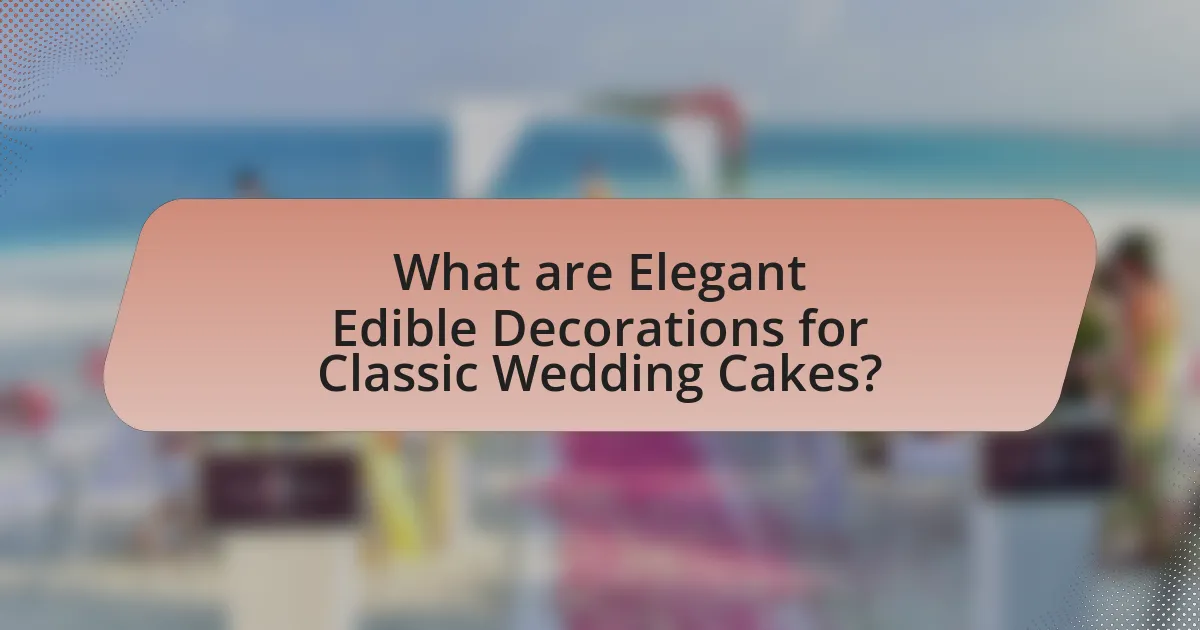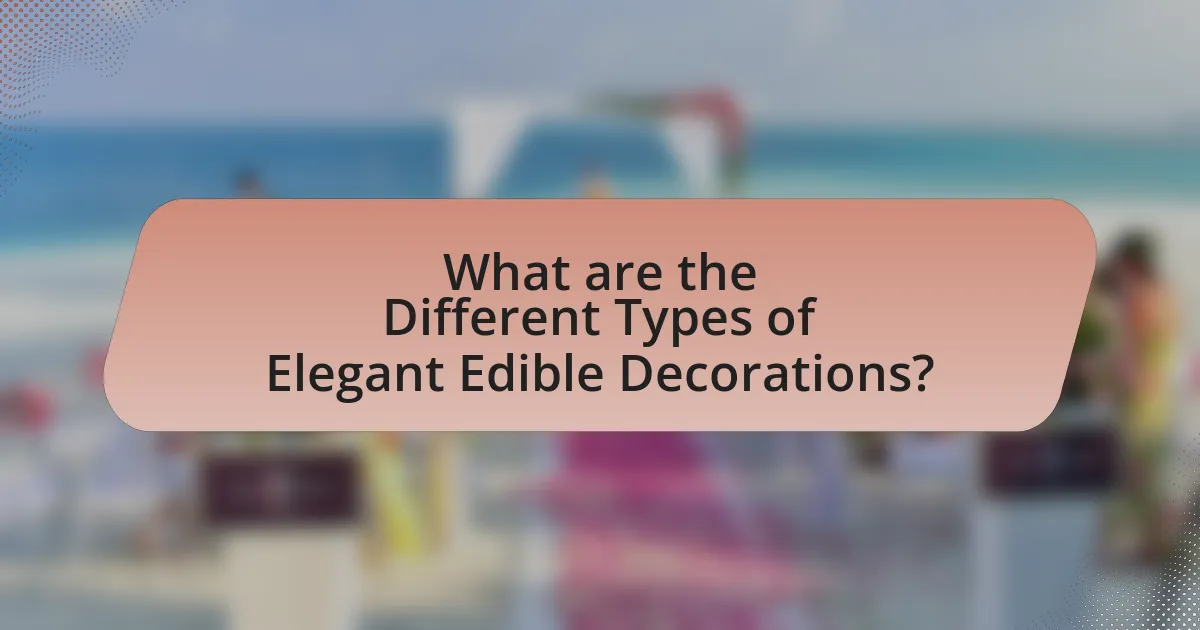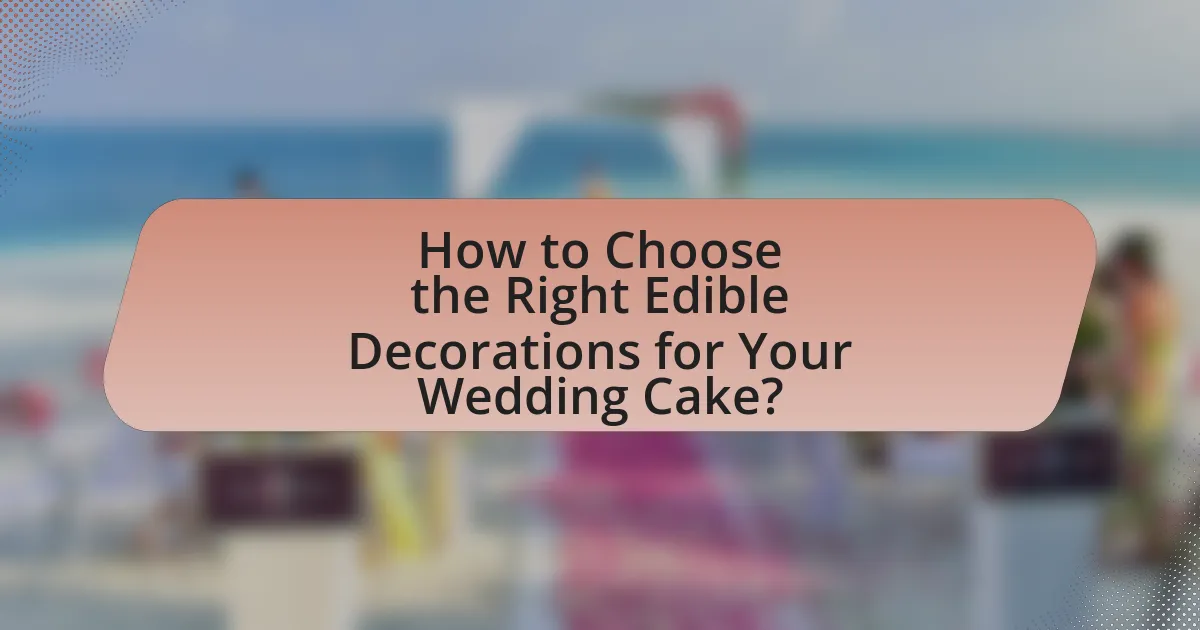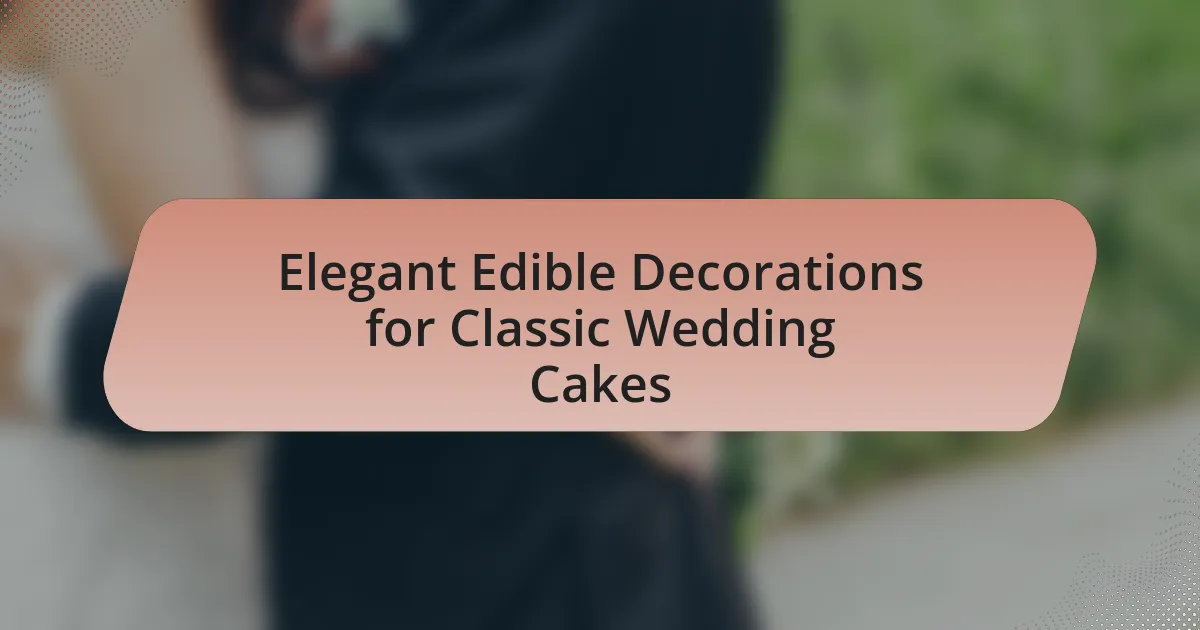Elegant edible decorations for classic wedding cakes encompass a variety of elements such as sugar flowers, fondant accents, edible gold leaf, and intricate piping designs. These decorations enhance the visual appeal and thematic coherence of wedding cakes, aligning with traditional aesthetics while also contributing to flavor profiles. Common materials used include fondant, gum paste, marzipan, chocolate, and royal icing, each offering unique benefits for cake design. The article explores how color and design choices impact elegance, the advantages of using edible over non-edible decorations, and practical tips for selecting and applying these decorative elements to achieve a sophisticated presentation.

What are Elegant Edible Decorations for Classic Wedding Cakes?
Elegant edible decorations for classic wedding cakes include sugar flowers, fondant accents, edible gold leaf, and intricate piping designs. Sugar flowers, crafted from gum paste or fondant, mimic real blooms and add a touch of sophistication. Fondant accents can be shaped into various designs, such as bows or lace patterns, enhancing the cake’s elegance. Edible gold leaf provides a luxurious finish, while intricate piping designs showcase skilled craftsmanship. These decorations not only enhance the visual appeal but also align with traditional wedding aesthetics, making them popular choices for couples seeking a classic look.
How do these decorations enhance the overall aesthetic of wedding cakes?
Decorations enhance the overall aesthetic of wedding cakes by adding visual appeal and thematic coherence. These embellishments, such as intricate sugar flowers, delicate lace patterns, and elegant metallic accents, create a stunning focal point that draws attention and elevates the cake’s design. For instance, sugar flowers can mimic the bride’s bouquet, reinforcing the wedding theme and color palette, while lace patterns can evoke a sense of sophistication and tradition. The use of high-quality edible materials ensures that these decorations not only look beautiful but also complement the cake’s flavor, making the overall experience more enjoyable for guests.
What types of edible materials are commonly used for these decorations?
Commonly used edible materials for decorations on classic wedding cakes include fondant, gum paste, marzipan, chocolate, and royal icing. Fondant is a smooth, pliable icing that can be rolled out and shaped into various designs, making it ideal for covering cakes and creating intricate decorations. Gum paste, similar to fondant but drier, is often used for delicate flowers and detailed embellishments due to its ability to hold shapes well. Marzipan, made from ground almonds and sugar, is frequently used for covering cakes or creating decorative figures. Chocolate, in various forms such as ganache or molded shapes, adds richness and versatility to cake designs. Royal icing, a mixture of egg whites and powdered sugar, is used for piping intricate designs and decorations, providing a hard finish that can be shaped into various forms. These materials are favored for their aesthetic appeal and versatility in creating elegant decorations that enhance the visual presentation of wedding cakes.
How do color and design choices impact the elegance of the decorations?
Color and design choices significantly enhance the elegance of decorations by creating visual harmony and evoking specific emotions. For instance, a palette of soft pastels can convey romance and sophistication, while bold colors may add vibrancy and energy. Research indicates that color psychology plays a crucial role in perception; for example, blue is often associated with calmness and trust, while red can evoke passion and excitement. Additionally, design elements such as symmetry and balance contribute to an overall refined appearance, as seen in classic wedding cake designs that often feature intricate patterns and elegant shapes. These choices collectively influence how decorations are perceived, reinforcing the elegance of the overall presentation.
Why are edible decorations preferred over non-edible options?
Edible decorations are preferred over non-edible options because they enhance the overall aesthetic while being safe for consumption. This preference is rooted in the desire for both visual appeal and practicality, as edible decorations can complement the flavors of the cake and contribute to the overall dining experience. For instance, sugar flowers and chocolate embellishments not only look attractive but also add taste, making them a more integrated part of the dessert. Additionally, using edible decorations eliminates concerns about potential hazards associated with non-edible items, such as choking or contamination, thereby ensuring a safer experience for guests.
What are the benefits of using edible decorations for wedding cakes?
Using edible decorations for wedding cakes enhances both aesthetics and taste, providing a visually appealing and flavorful experience. Edible decorations, such as sugar flowers or chocolate embellishments, contribute to the overall design of the cake while ensuring that every element is consumable, eliminating waste. Additionally, these decorations can be customized to match the wedding theme or color palette, offering personalization that non-edible options cannot provide. The use of edible materials also aligns with food safety standards, ensuring that all components of the cake are safe for guests to eat.
How do edible decorations contribute to the cake’s flavor profile?
Edible decorations enhance a cake’s flavor profile by adding complementary tastes and textures. For instance, chocolate shavings introduce a rich, sweet flavor, while fresh fruits can provide acidity and freshness, balancing the overall sweetness of the cake. Additionally, flavored glazes or icings can infuse the cake with unique tastes, such as citrus or vanilla, further enriching the flavor experience. The combination of these elements creates a multi-dimensional flavor profile that elevates the cake beyond its base ingredients.

What are the Different Types of Elegant Edible Decorations?
Elegant edible decorations include sugar flowers, fondant accents, edible gold leaf, chocolate decorations, and fruit garnishes. Sugar flowers are crafted from gum paste or fondant, mimicking real blooms and adding a delicate touch to cakes. Fondant accents can be molded into various shapes and designs, providing a smooth finish and versatility in decoration. Edible gold leaf adds a luxurious element, often used to highlight specific areas of the cake. Chocolate decorations, such as curls or molded shapes, offer a rich flavor and artistic flair. Lastly, fresh fruit garnishes not only enhance visual appeal but also provide natural flavors, making them a popular choice for elegant cake presentations.
What are the most popular edible decoration styles for wedding cakes?
The most popular edible decoration styles for wedding cakes include fondant, buttercream, fresh flowers, and sugar flowers. Fondant provides a smooth, polished finish and allows for intricate designs, making it a favorite among cake decorators. Buttercream, known for its creamy texture and versatility, can be piped into various shapes and patterns, offering a more traditional look. Fresh flowers add a natural and vibrant touch, often chosen to match the wedding’s color scheme. Sugar flowers, crafted from gum paste or fondant, can replicate real blooms and are favored for their longevity and artistic detail. These styles are widely used due to their aesthetic appeal and ability to enhance the overall presentation of wedding cakes.
How do sugar flowers differ from fresh flowers in cake decoration?
Sugar flowers differ from fresh flowers in cake decoration primarily in their composition and longevity. Sugar flowers are crafted from edible materials like gum paste or fondant, allowing them to maintain their shape and color indefinitely, while fresh flowers can wilt and degrade over time due to moisture and temperature changes. Additionally, sugar flowers can be designed to match specific color schemes and styles, providing greater customization options for cake decorators. In contrast, fresh flowers are limited by seasonal availability and may require careful selection to ensure they are safe for consumption.
What role do fondant and gum paste play in creating elegant designs?
Fondant and gum paste are essential materials in creating elegant designs for wedding cakes. Fondant provides a smooth, polished surface that can be molded and shaped into various forms, allowing for intricate detailing and a refined appearance. Gum paste, on the other hand, is more pliable and dries harder, making it ideal for creating delicate decorations such as flowers and figurines that maintain their shape. Both materials can be colored and flavored, enhancing the visual and taste appeal of the cake. Their versatility and ability to hold fine details make them indispensable in achieving the sophisticated aesthetics desired in classic wedding cake designs.
How can edible glitter and luster dust enhance cake decorations?
Edible glitter and luster dust enhance cake decorations by adding visual appeal and a touch of elegance. These decorative elements create a shimmering effect that catches the light, making cakes more eye-catching and festive. For instance, luster dust can be applied to fondant or buttercream to give a metallic finish, while edible glitter can be sprinkled on top for a sparkling effect. The use of these materials is supported by their popularity in the baking industry, where they are frequently used in high-end cake designs for weddings and special occasions, demonstrating their effectiveness in elevating the overall aesthetic of cake decorations.
What techniques are used to apply edible glitter effectively?
To apply edible glitter effectively, techniques include using a brush for precise application, mixing glitter with a clear edible adhesive, and dusting it onto wet surfaces. The brush technique allows for controlled placement, ensuring that the glitter adheres only where desired. Mixing glitter with a clear edible adhesive creates a paste that can be spread evenly across surfaces, enhancing the glitter’s visibility and adherence. Dusting glitter onto wet surfaces, such as freshly frosted cakes, ensures that the glitter sticks well and creates a sparkling effect. These methods are commonly used in cake decorating to achieve a visually appealing finish.
How does luster dust affect the visual appeal of cake decorations?
Luster dust enhances the visual appeal of cake decorations by adding a shimmering, metallic finish that catches light and creates depth. This effect elevates the overall aesthetic, making cakes appear more luxurious and sophisticated. The use of luster dust can transform simple designs into eye-catching focal points, as it provides a contrast against matte surfaces and highlights intricate details. Studies in food presentation indicate that visual enhancements, such as those provided by luster dust, can significantly influence perceptions of taste and quality, reinforcing its importance in cake decoration.

How to Choose the Right Edible Decorations for Your Wedding Cake?
To choose the right edible decorations for your wedding cake, consider the overall theme and color palette of your wedding. Selecting decorations that complement your wedding’s aesthetic ensures visual harmony. For instance, if your wedding features soft pastels, opt for delicate sugar flowers or pastel-colored macarons. Additionally, assess the flavor profile of your cake; pairing flavors with corresponding decorations enhances the taste experience. For example, citrus-flavored cakes pair well with candied citrus slices. Finally, prioritize quality and safety by sourcing decorations from reputable suppliers, ensuring they are made from food-safe materials. This approach guarantees that your edible decorations not only look beautiful but also taste great and are safe for consumption.
What factors should be considered when selecting edible decorations?
When selecting edible decorations for classic wedding cakes, factors such as taste, compatibility with the cake flavor, visual appeal, and dietary restrictions must be considered. Taste is crucial because the decorations should enhance the overall flavor experience; for example, chocolate decorations pair well with vanilla cakes. Compatibility with the cake flavor ensures that the decorations complement rather than clash with the main dessert. Visual appeal is important for aesthetic purposes, as decorations should align with the wedding theme and color scheme. Lastly, dietary restrictions, such as allergies or preferences for vegan or gluten-free options, must be taken into account to ensure all guests can enjoy the cake.
How do personal preferences and wedding themes influence decoration choices?
Personal preferences and wedding themes significantly influence decoration choices by dictating the style, color palette, and overall aesthetic of the event. For instance, a couple who favors a rustic theme may opt for natural elements like burlap and wildflowers, while those leaning towards a classic theme might choose elegant fabrics and traditional floral arrangements. Research indicates that 70% of couples prioritize personal style in their wedding planning, which directly impacts their decoration selections. This alignment between personal taste and thematic elements ensures that the decorations resonate with the couple’s identity and vision for their special day.
What is the importance of coordinating decorations with the cake flavor?
Coordinating decorations with the cake flavor is crucial for enhancing the overall sensory experience of the dessert. When decorations complement the cake flavor, they create a harmonious balance that elevates taste and visual appeal. For instance, a chocolate cake adorned with rich chocolate ganache and dark chocolate shavings reinforces the flavor profile, making the cake more enjoyable. This alignment not only satisfies the palate but also meets the expectations of guests, as they often anticipate that the visual elements will reflect the taste. Studies in culinary arts emphasize that flavor and presentation are interconnected, with successful pairings leading to higher satisfaction rates among consumers.
What are some tips for working with edible decorations?
To effectively work with edible decorations, ensure that all materials are fresh and suitable for the intended cake design. Fresh flowers, for instance, should be pesticide-free and safe for consumption, while sugar decorations must be stored properly to maintain their quality. Additionally, use a light touch when applying decorations to avoid damaging delicate elements. For instance, when placing edible glitter or dust, a gentle hand prevents clumping and ensures an even distribution. Properly pairing flavors with decorations enhances the overall taste experience; for example, chocolate decorations complement vanilla cakes well. Lastly, consider the structural integrity of the cake; heavier decorations may require additional support to prevent them from sinking or causing the cake to collapse.
How can you ensure the stability of decorations on a multi-tiered cake?
To ensure the stability of decorations on a multi-tiered cake, use structural supports such as dowels or straws to reinforce each tier. These supports prevent the weight of the upper tiers from collapsing onto the lower ones, maintaining the integrity of the cake’s design. Additionally, applying a layer of buttercream or ganache between the cake and decorations helps secure them in place. Research indicates that using at least one dowel per tier, along with proper stacking techniques, significantly reduces the risk of shifting or toppling during transport and display.
What common mistakes should be avoided when decorating with edible elements?
Common mistakes to avoid when decorating with edible elements include neglecting food safety, using non-edible materials, and failing to consider flavor compatibility. Food safety is crucial; for instance, using fresh flowers that are not food-safe can lead to health risks. Additionally, incorporating non-edible decorations, such as plastic or metal, can mislead guests and detract from the overall aesthetic. Lastly, mismatched flavors can result in an unpleasant experience; for example, pairing overly sweet decorations with a savory cake can clash. These mistakes can compromise both the visual appeal and the enjoyment of the cake.
What are the best practices for maintaining the quality of edible decorations?
The best practices for maintaining the quality of edible decorations include proper storage, temperature control, and using high-quality ingredients. Storing edible decorations in a cool, dry place prevents moisture and heat from causing deterioration. For instance, chocolate decorations should be kept at temperatures below 70°F to avoid melting or blooming. Additionally, using fresh, high-quality ingredients ensures that the decorations not only look appealing but also taste good, as stale or low-quality components can compromise both appearance and flavor. Regularly checking for signs of spoilage, such as discoloration or off-odors, further helps in maintaining their quality.
